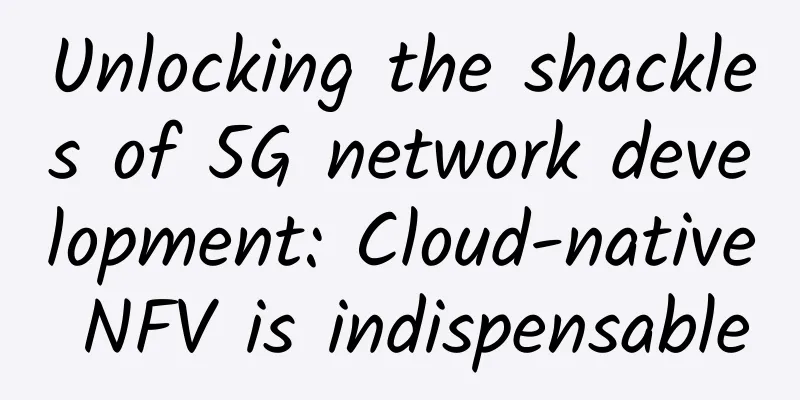Unlocking the shackles of 5G network development: Cloud-native NFV is indispensable

|
The implementation of 5G technology will bring the industry an unprecedented ultra-reliable, low-latency communication experience, but today's mobile networks are not set up according to the needs of 5G. Mobile network limitations are built in the model of 2 traditional telephone networks, with wireless coverage up to one kilometer. In order to make 5G possible, they need to borrow more scalable and flexible network principles from companies such as Netflix and Google to provide cloud-based services. The future network requires more than just RAN upgrades, a new type of core network is needed to provide services, scale, security and quality of experience. These requirements will bring great challenges to network operators, who need to virtualize network functions to support their network services and cost-effectively expand to billions of devices.
The development of two key technologies will free today’s network operators from the shackles of 5G network development: cloud-native NFV and mobile edge computing (MEC). Native cloud NFV is more than just migrating functions to cheaper hardware. This approach effectively leverages the key advantages of cloud computing: it is a new distributed computing environment that is scalable, elastic, and fault-tolerant, without the one-to-one redundancy of traditional telecom networks. Therefore, only native cloud VNFs can reduce the impact of failures at any level of the technology stack through appropriate surplus capacity and automatic repair capabilities. With this technology, 5G networks will be able to automatically repair and smooth, able to meet almost any demand or consumption surge, and network operators will gain new profit points from the transformation from customization to commercialization. However, 5G networks also require other functions at their foundation, namely the core capabilities of the network edge. The low latency expected in 5G networks also brings the need for network operators to move core IT functions closer to the edge of the network. MEC approaches this problem by providing an IT service environment (computing, processing and storage) at the edge of the radio access network (RAN) (once the PGW function is moved from the EPC to the edge). MEC still uses the mobile operator's existing NFV infrastructure, management and business processes, and can use dedicated platforms or other business processes and VNFs to share resources. With the widespread use of MEC in cloud-native virtualized 5G networks, network operators can provide services to users for mobile applications that require high-speed data processing and low latency (augmented reality, autonomous vehicles), providing a new mobile experience. Even on the fastest mobile networks operated by network operators today, MEC can achieve faster response events in applications with transmission and routing delays, as well as incredibly high video resolution and audio quality. The cloud-native approach to NFV and MEC provides network operators with the network foundation they need to build future 5G networks. The good news is that network operators can now evolve their architecture by supporting VoLTE. Using cloud-native VNFs to quickly add IMS functions, network security and media translation through session border controllers, cloud-based message storage and synchronization, and new services created by telephony application servers set up network operators' evolution to 5G networks, while also providing today's network operators with the opportunity to gain additional profit points. What matters most to network operators is the core network technology they are using to support voice services on 4G LTE networks and to pave the way for more flexible and forward-looking offerings. Network operators are now beginning to transform to cloud-native networks to take full advantage of VoLTE, mobile unified communications and a new generation of voice-enabled IoT devices, applications and services, creating a new beginning for network operators to build the network foundation and development environment that will make 5G networks a reality. |
<<: Huawei Cloud meets in a blessed place, connecting the present and future of Fujian
>>: VXLAN L3 applies EVPN to present a complete overlay network
Recommend
In-depth | Only IT people can understand "Journey to the West"
As a TV series that has been rebroadcast thousand...
Megalayer September promotion: Hong Kong dual E5 server from 399 yuan/month, Hong Kong 20G high-defense server from 499 yuan/month
Megalayer has launched its September event, offer...
Cisco: Continuous innovation to create an inclusive future
On June 14, Cisco's annual networking and sec...
2017 F5 makes applications fly!
[51CTO.com original article] In 2017, what will y...
The correct way to calculate network bandwidth requirements
Different networks have different bandwidth requi...
Can lightweighting become the spark that sets 5G off?
At the 31st PT Expo held recently, 5G became the ...
Manually sending packets only handshakes twice, I discovered the secret of TCP
[[399328]] Planet Questions There are at least 9,...
China Unicom SMS has a large-scale failure: mobile phones cannot receive verification codes. Official: Emergency processing is in progress
On February 10, the last working day, China Unico...
Interview Frequent: Talk about everything about HTTP caching
Speed, speed, and speed. If a website wants to pr...
Wi-Fi Alliance launches next-generation WPA3 security certification program
[51CTO.com original article] On June 26, the Wi-F...
How much power does 5G base stations consume? It is expected to account for 2.1% of the total electricity consumption in society
As we all know, since the first half of the year,...
Network Slicing "Hot Pot Theory": Same Pot, Different Dreams
In the dog days of summer, when people are "...
P2P market needs regular troops. Yunyou Holdings acquires Jianlicai to focus on technology finance
[51CTO.com original article] The earliest P2P onl...
spinservers: $59/month - E3-1280v5, 32GB memory, 1TB NVMe, 30TB/10Gbps bandwidth
spinservers has just released several promotional...









